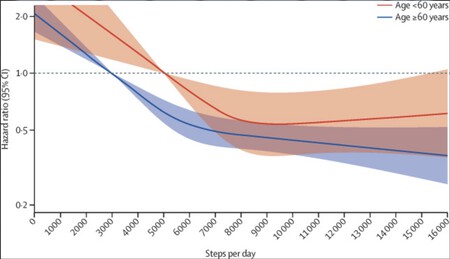For years, the manufacturers of smartwatches and quantifying bracelets have sold us that we had to walk 10,000 steps a day. The figure has already been etched in popular culture, but the curious thing is that studies that contradict the myth do not stop appearing. Now one of them has resurfaced, and the recommended figure is quite different.
Who invented the 10,000 steps thing? In 1965, a Japanese company launched a pedometer called the Manpo-Kei. The translation of that name is “10,000 step meter”, and according to Japanese researchers, the reason for choosing that number was because 10,000, 万, is similar to a walking man. And suddenly everyone assumed that those 10,000 steps were the ideal daily amount to maintain good physical activity.
The fact is that this number has become an urban legend, and most devices that monitor our physical activity —such as smart watches or activity bracelets— take it as a reference. Fortunately, in all or almost all of them it is possible to establish a custom figure.
There are other theories. Science confirmed that 10,000 steps was unfounded, and a study published in JAMA revealed that the optimal number of daily steps was around 8,000. From there the benefits were modest, so walking more and more doesn’t make much sense either if you’re looking to maximize the benefits of taking a certain number of steps.

Now the good figure is 7,000 (for those over 60). Says a meta-study published in the Lancet. There they grouped 15 studies that had been carried out between 1999 and 2018 and that had grouped more than 47,000 adults.
After analyzing the data, it was concluded that the risk of mortality was reduced by 50% in older adults who increased the number of daily steps from 3,000 to 7,000 steps. Taking 10,000 steps barely reduced that percentage of risk, although there were benefits (not many) if they walked twice as much.
If you are under 60, the ideal figure is around 8,000. The surprise is in those under 60 years of age: the risk drops significantly up to approximately 8,000 steps, but from there, walking more seems even harmful. It is striking, because according to that study, we should not even consider walking more than that figure: doing so slightly increases the risk of mortality instead of reducing it.
The WHO does not count steps, but activity time. For the World Health Organization, steps don’t even seem like an adequate metric. In their recommendations, what is taken into account is the time of physical activity, which varies according to age ranges.
Thus, it is said that adults aged 18 to 64 “moderate aerobic physical activities for at least 150 to 300 minutes or intense aerobic physical activities for at least 75 to 150 minutes.” Spending even more time is beneficial, they say, and they additionally recommend “muscle-strengthening activities two or more days a week.” The curious thing is that this recommendation does not change much for those over 64 years of age.
Moving is good, but each person is a world. The truth is that it has been proven many times that walking is good for your health, and our often sedentary lives do not help. These studies and these figures are, however, a reference without further ado. And one that has its dangers: it can sink those unable to achieve those goals and discourage them. Let each one make a coat out of his cape, then. But if you do it by walking a little, all the better.
George is Digismak’s reported cum editor with 13 years of experience in Journalism
